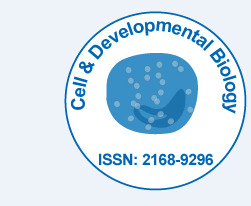
Cell & Developmental Biology
Open Access
ISSN: 2168-9296

ISSN: 2168-9296
Commentary - (2025)Volume 14, Issue 1
Extracellular Matrix (ECM) remodeling represents a fundamental process during tissue morphogenesis that involves the dynamic modification of the structural and biochemical properties of the extracellular environment. The ECM provides essential mechanical support, signaling cues, and organizational frameworks that guide cellular behavior during development. The coordinated remodeling of ECM components enables the complex morphogenetic movements, tissue patterning, and cellular differentiation events that characterize embryonic development. Understanding ECM remodeling mechanisms has profound implications for developmental biology, regenerative medicine, and the pathogenesis of developmental disorders.
The extracellular matrix consists of a complex network of proteins, glycoproteins, and polysaccharides that provide structural support and regulatory information to cells. Major ECM components include collagens, which provide tensile strength and structural integrity; fibronectin and laminin, which regulate cell adhesion and migration; proteoglycans, which influence tissue hydration and growth factor signaling; and elastin, which provides elastic properties to tissues. The composition and organization of these components vary between tissues and developmental stages, creating tissue-specific microenvironments that guide cellular behavior.
Collagen represents the most abundant ECM protein and undergoes extensive remodeling during tissue morphogenesis. The collagen family includes over 25 different types with specialized functions and tissue distributions. Type I collagen provides structural support in bone, tendon, and skin, while type IV collagen is a major component of basement membranes. Collagen synthesis involves complex post-translational modifications including hydroxylation, glycosylation, and cross-linking that are essential for proper collagen structure and function. The regulation of collagen gene expression, protein processing, and cross-linking creates tissue-specific collagen networks with distinct mechanical properties.
Matrix Metalloproteinases (MMPs) represent the primary enzymes responsible for ECM degradation and remodeling during development. This family of zinc-dependent endopeptidases includes collagenases, gelatinases, stromelysins, and membrane-type MMPs, each with specific substrate preferences and regulatory mechanisms. MMP activity is precisely controlled through transcriptional regulation, zymogen activation, and inhibition by Tissue Inhibitors of Metalloproteinases (TIMPs). The spatiotemporal control of MMP activity enables localized ECM remodeling that facilitates cellular migration, tissue invasion, and morphogenetic movements.
The mechanical properties of the ECM profoundly influence cellular behavior during development through mechanotransduction pathways. ECM stiffness, fiber organization, and topography provide mechanical cues that regulate cell fate decisions, migration patterns, and differentiation programs. Cells sense and respond to these mechanical properties through integrin-mediated adhesions, mechanosensitive ion channels, and cytoskeletal networks. The dynamic remodeling of ECM mechanical properties during development creates changing mechanical landscapes that guide morphogenetic processes.
Basement membranes represent specialized ECM structures that play crucial roles in tissue organization and morphogenesis. These thin, sheet-like structures separate epithelia from underlying mesenchyme and provide essential signals for epithelial polarity and differentiation. Basement membranes undergo extensive remodeling during development, including assembly, degradation, and reconstruction processes that facilitate tissue morphogenesis. The regulation of basement membrane integrity is essential for proper organ formation and is disrupted in many developmental disorders.
ECM remodeling is intimately linked to angiogenesis, the formation of new blood vessels from existing vasculature. Endothelial cells must degrade and reorganize ECM components to enable sprouting, migration, and tube formation. The ECM provides guidance cues for vessel patterning and regulates endothelial cell behavior through the presentation of growth factors and mechanical signals. The coordinated remodeling of ECM and vascular networks is essential for proper organ development and function.
Neural crest cell migration represents a paradigmatic example of ECM-guided morphogenesis. These multipotent cells undergo extensive migrations through developing embryos to reach their target tissues, where they differentiate into diverse cell types. Neural crest cell migration requires the coordinated remodeling of ECM components along migration pathways, including the degradation of restrictive matrices and the deposition of permissive substrates. The ECM provides directional cues, stop signals, and differentiation instructions that guide neural crest cell fate and positioning.
The regulation of growth factor signaling by ECM components represents an important mechanism for controlling developmental processes. Many growth factors bind to ECM components, creating localized concentration gradients and protecting factors from degradation. Heparan sulfate proteoglycans serve as co-receptors for numerous growth factors and regulate their binding to cellular receptors. The remodeling of ECM components can release sequestered growth factors, creating dynamic signaling environments that change during development.
Tissue engineering and regenerative medicine applications have highlighted the importance of ECM remodeling in tissue formation and repair. Biomaterial scaffolds that mimic ECM properties can guide cellular behavior and tissue formation in vitro and in vivo. The development of ECM-derived biomaterials and the engineering of ECM-remodeling pathways represent promising approaches for tissue regeneration. Understanding natural ECM remodeling processes informs the design of biomaterials and therapeutic strategies for tissue repair.
Extracellular matrix remodeling represents a fundamental mechanism that enables tissue morphogenesis through the dynamic modification of the cellular microenvironment. The coordinated action of ECM synthesis, degradation, and organization creates complex three-dimensional structures that guide cellular behavior during development. The mechanical and biochemical properties of the ECM provide essential information for cell fate decisions, migration patterns, and differentiation programs. Understanding ECM remodeling mechanisms has important implications for developmental biology, tissue engineering, and the development of therapeutic strategies for developmental disorders and tissue repair applications.
Citation: Havens J (2025). Extracellular Matrix Remodeling during Tissue Morphogenesis. Cell Dev Biol. 14:388.
Received: 03-Mar-2025, Manuscript No. CDB-25-38140; Editor assigned: 05-Mar-2025, Pre QC No. CDB-25-38140 (PQ); Reviewed: 19-Mar-2025, QC No. CDB-25-38140; Revised: 26-Mar-2025, Manuscript No. CDB-25-38140 (R); Published: 02-Apr-2025 , DOI: 10.35248/2168-9296.25.14.388
Copyright: © 2025 Havens J. This is an open-access article distributed under the terms of the Creative Commons Attribution License, which permits unrestricted use, distribution, and reproduction in any medium, provided the original author and source are credited.